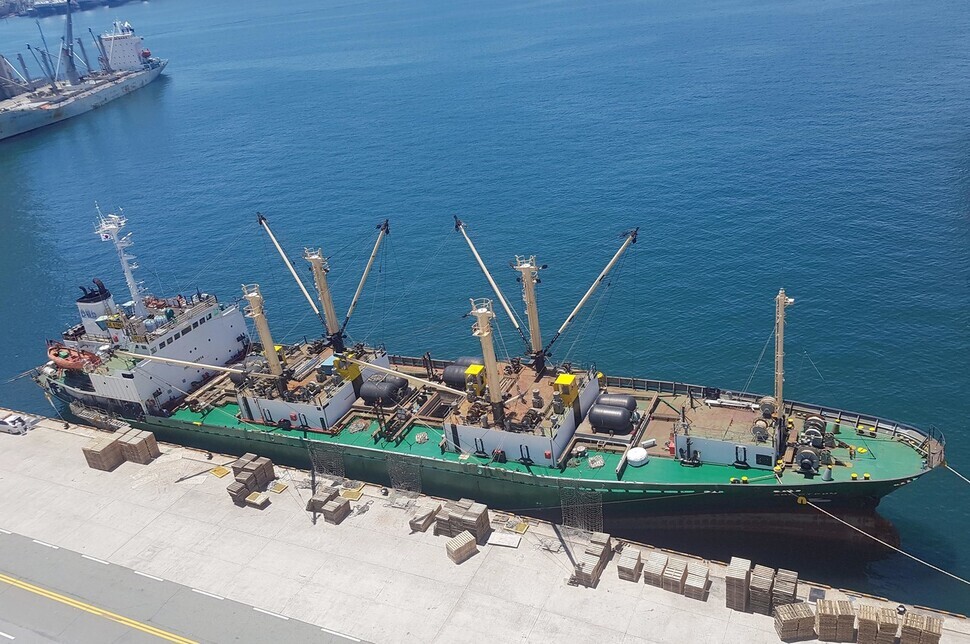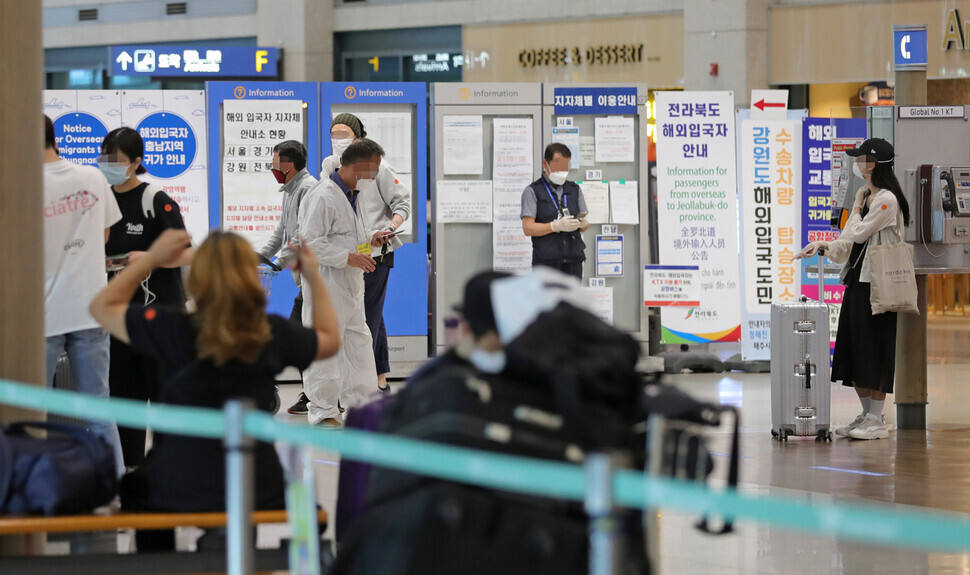hankyoreh
Links to other country sites 다른 나라 사이트 링크
Russian reefer ships did not alert authorities of crew members with COVID-19 symptoms before docking

The operator of Russian two reefer ships failed to alert South Korean customs authorities before docking that it had a large number of suspected cases of COVID-19 on board. The ship was also allowed to dock in Busan after going through a streamlined “electronic quarantine inspection” process, despite the unsettling recent rise of COVID-19 cases in Russia. In short, issues with the quarantine inspection process seem to have led to a major outbreak of COVID-19 infections at Busan’s Gamcheon Port.
According to explanations provided by the Korea Centers for Disease Control and Prevention (KCDC) and the city of Busan on June 23, the ship, the Ice Stream, departed from Russia’s Vladivostok Port on June 16 and arrived at Busan’s Gamcheon Port at 8 am on June 21. The Ice Stream had 16 confirmed cases of COVID-19, while another Russian ship that had already docked at the port, the Ice Crystal, had one confirmed case. The remaining 25 other sailors from the two ships, along with all 176 dock workers and customs officials who had either boarded the ship or came into contact with crew members, have been quarantined and are currently being tested for the coronavirus.
The first reason the Ice Stream was allowed to dock and unload its cargo at the port without any restrictions was because the ship failed to alert South Korean quarantine inspection authorities about three sailors who showed COVID-19 symptoms, including a high fever. The ship also failed to properly record the state of health of sailors on board on a document concerning the health and sanitary conditions on the ship, which was submitted to South Korean quarantine authorities and whose submission is required under international health regulations stipulated by the World Health Organization (WHO). Kwon Jun-wook, deputy director of the KCDC, said that the operator of the Ice Stream could face a fine if South Korean authorities confirm that the ship violated the country’s quarantine inspection laws.
Another issue is that Russian ships have been allowed to submit documents through South Korea’s streamlined electronic quarantine inspection system. As of June 21, there had been more than 7,000 new COVID-19 cases reported every day over the past 10 days in 83 areas of Russia, including Moscow. In fact, the country has the third largest number of COVID-19 cases in the world, with an accumulated total of around 590,000 infections. Only ships from China, Iran and Italy, however, are required to allow South Korean quarantine officials to board and check whether sailors have been infected with COVID-19.
On June 21, Busan’s National Quarantine Station issued a document certifying that the Ice Stream had passed quarantine inspection after going through the electronic quarantine inspection process. Soon after that, a large number of dock workers came into contact with the ship’s sailors while the ship was being unloaded. “I know it’s late in the game, but we will now require Russian ships to be boarded for quarantine inspection,” Kwon said.

Meanwhile, a 50-year-old man from Kazakhstan along with another 30-year-old man from Pakistan who had been quarantined on June 22 tested positive yesterday for COVID-19. There has recently been a rise in COVID-19 cases among people who, after entering South Korea, have tested positive while in isolation or during the quarantine inspection process. As of 12 am yesterday, 30 of South Korea’s 46 new COVID-19 cases are people who entered South Korea from abroad. Lee Chang-jun, director of Residential Treatment Centers at the Central Accident Investigation Headquarters, said that there were only 10 spaces left at the Gyeonggi Anseong Center (the Woori Bank Training Center, with a capacity of 59 people), which serves as the only residential treatment center for foreigners in South Korea, further noting that the center is set to close at the end of this month. “We are preparing to open other residential treatment centers to care for foreign nationals and others living in the country’s central region once the Anseong center closes,” he added.
By Choi Ha-yan, staff reporter, and Kim Yeong-dong and Kim Kwang-soo, Busan correspondents,
Please direct comments or questions to [english@hani.co.kr]

Editorial・opinion
![[Column] How tragedy pervades weak links in Korean labor [Column] How tragedy pervades weak links in Korean labor](https://flexible.img.hani.co.kr/flexible/normal/500/300/imgdb/original/2024/0703/8717199957128458.jpg) [Column] How tragedy pervades weak links in Korean labor
[Column] How tragedy pervades weak links in Korean labor![[Column] How opposing war became a far-right policy [Column] How opposing war became a far-right policy](https://flexible.img.hani.co.kr/flexible/normal/500/300/imgdb/original/2024/0702/5017199091002075.jpg) [Column] How opposing war became a far-right policy
[Column] How opposing war became a far-right policy- [Editorial] Korea needs to adjust diplomatic course in preparation for a Trump comeback
- [Editorial] Silence won’t save Yoon
- [Column] The miscalculations that started the Korean War mustn’t be repeated
- [Correspondent’s column] China-Europe relations tested once more by EV war
- [Correspondent’s column] Who really created the new ‘axis of evil’?
- [Editorial] Exploiting foreign domestic workers won’t solve Korea’s birth rate problem
- [Column] Kim and Putin’s new world order
- [Editorial] Workplace hazards can be prevented — why weren’t they this time?
Most viewed articles
- 1South Koreans living near border with North unnerved by return of artillery thunder
- 2Car behind deadly crash began rapid acceleration after exiting underground garage
- 3S. Korea “monitoring developments” after report of secret Chinese police station in Seoul
- 4Democrats ride wave of 1M signature petition for Yoon to be impeached
- 510 days of torture: Korean mental patient’s restraints only removed after death
- 6In the blink of an eye, an unthinkable crash turned a night out into a nightmare
- 7[Column] How tragedy pervades weak links in Korean labor
- 8Hyundai Motor sets up one-stop shop for EV production in Indonesia
- 9Families, friends mourn loved ones cut down in prime in deadly car crash
- 10[Editorial] Korea needs to adjust diplomatic course in preparation for a Trump comeback